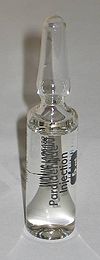Paraldehyde
Paraldehyde slowly oxidizes in air, turning brown and producing an odour of acetic acid.
He found it quite remarkable that when paraldehyde was heated with a trace of the same acid, the reaction went the other way, recreating acetaldehyde.
For example, it is used as-is in the synthesis of bromal (tribromoacetaldehyde):[13] Paraldehyde was introduced into clinical practice in the UK by the Italian physician Vincenzo Cervello (1854–1918) in 1882.
[14][15][16] It is a central nervous system depressant and was soon found to be an effective anticonvulsant, hypnotic and sedative.
Paraldehyde was the last injection given to Edith Alice Morrell in 1950 by the suspected serial killer John Bodkin Adams.
It was commonly used to induce sleep in sufferers from delirium tremens but has been replaced by other drugs in this regard.
Since the dose margin between the anticonvulsant and hypnotic effect is small, paraldehyde treatment usually results in sleep.
It reacts with rubber and plastic which limits the time it may safely be kept in contact with some syringes or tubing before administration.

